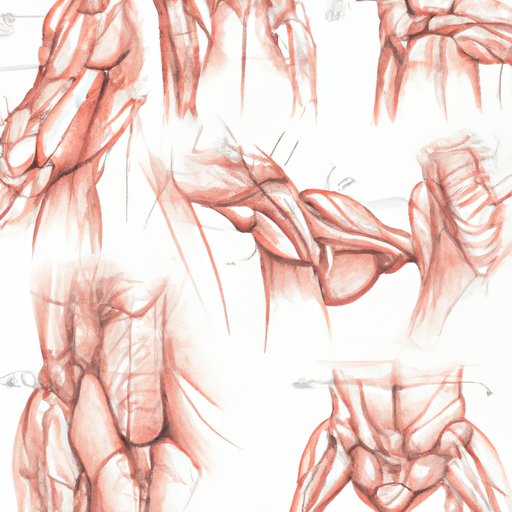
Introduction
Drawing realistic muscles is a challenge that many artists face. Whether you’re a beginner or an experienced artist, understanding the anatomy and how to shade and texture muscles can be tricky. This article will provide you with a comprehensive guide to drawing muscles, covering everything from basic anatomy to advanced techniques.
10 Tips and Tricks for Drawing Muscles Like a Pro
Before diving into the details, here are ten practical tips and tricks that can help you master the art of drawing muscles:
- Use reference images to understand the shape and form of different muscles.
- Master proportion by breaking down the body into simple shapes and slowly building it up.
- Understand muscle groups and their functions to achieve a realistic depiction.
- Start with simple sketches before adding details.
- Pay attention to lighting and shading, which can create depth and dimension.
- Experiment with different tools like pencils, pens, and markers to find what works for you.
- Try different angles and positions to understand how muscles move and stretch.
- Observe real-life models or use online resources to study muscle anatomy.
- Practice regularly to improve your skills and become familiar with different muscle structures.
- Be patient and don’t give up, drawing muscles takes time and effort.
An Artist’s Guide to Drawing Muscles: Techniques and Tutorials
Once you have a grasp of the basics, it’s time to delve into different techniques for drawing muscles. Here are some step-by-step tutorials and techniques:
- Crosshatching: use diagonal and parallel lines to create shading and depth.
- Stippling: use small dots to create texture and shadow.
- Contouring: use lines to define the shape and form of the muscles.
- Study bone structure to create realistic poses and movements.
- Use blending tools like tissue paper or blending stumps to smooth out shading and create a more polished look.
- Practice drawing different muscle groups, including the biceps, triceps, abs, and quads.
The Muscle Anatomy: A Comprehensive Guide to Drawing Realistic Muscles
Understanding the anatomy of muscles is essential for realistic depictions. Here are some key points to keep in mind:
- There are three types of muscles: smooth, cardiac, and skeletal.
- Skeletal muscles are the ones we see and interact with on a daily basis.
- Muscles work in pairs, with one muscle contracting while the other relaxes.
- Muscles are connected to bones by tendons.
- Each muscle has a specific function, like flexion or extension.
Mastering the Art of Shading: How to Add Dimension to Muscular Drawings
Shading is essential for creating depth and dimension in muscle drawings. Here are some tips for mastering shading:
- Start with a light hand, slowly building up the shading as you go along.
- Pay attention to the direction of light and how it affects the muscles.
- Use a range of values to create a three-dimensional effect.
- Experiment with different shading techniques, like hatching or stippling.
- Use a blending tool or your finger to smooth out the shading and create a polished look.
Drawing Inspiration: Muscular Drawings from Famous Artists and How to Achieve Similar Results
Learning from other artists is a great way to improve your own skills. Here are some inspiring muscular drawings:
- Michelangelo’s David, which showcases the intricate details of the human body and its muscles.
- Frank Frazetta’s fantasy art, which often features thought-provoking depictions of muscle-bound warriors and heroes.
- Joe Jusko’s comic book art, which combines anatomy and storytelling to create visually stunning muscular characters.
To achieve similar results, pay attention to the techniques used by these artists, such as attention to detail, dynamic poses, and strong shading techniques.
Beyond the Basics: Advanced Techniques for Drawing Muscles and Honing Your Craft
For artists looking to take their muscle-drawing skills to the next level, here are some advanced techniques to try:
- Render muscles in motion, which requires understanding how different muscles work in conjunction with each other to create movement.
- Experiment with different textures, such as rock-hard biceps or supple abs.
- Use digital tools, like apps or software, to create realistic depictions of muscle structure and movement.
Conclusion
Drawing muscles takes time, effort, and practice. By following these tips and techniques, you can master the art and create realistic and dynamic muscle drawings. Remember to study muscle anatomy, pay attention to lighting and shading, and experiment with different techniques and tools.





